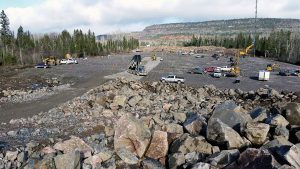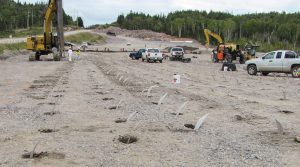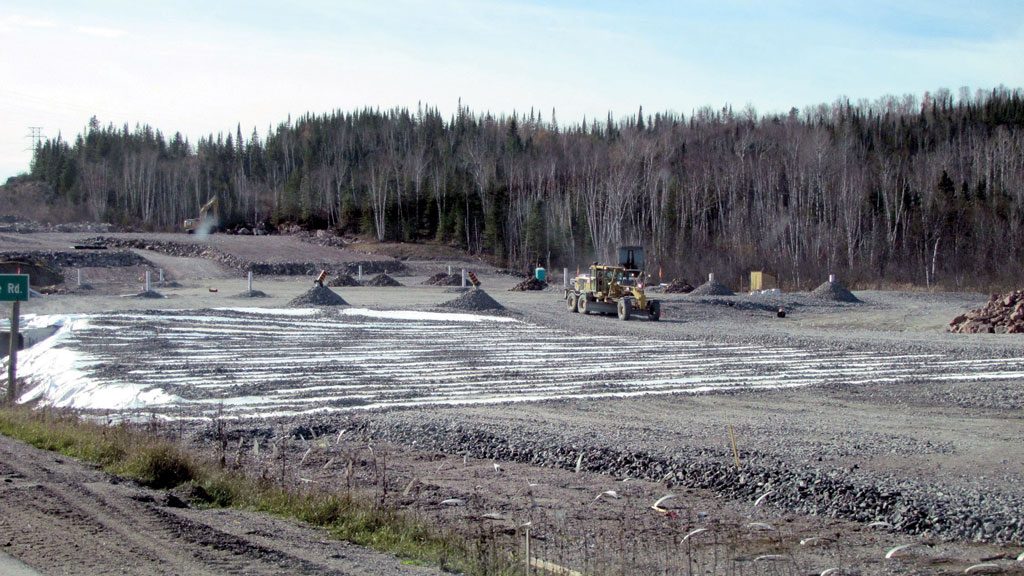Under construction since June 2015, the widening of an approximately 12-kilometre-long (7.4-mile) stretch of Highway 11/17 between Stillwater Creek to Red Rock Road No. 9 just west of Nipigon is expected to be finished this June, two years ahead of the fixed completion date of June 2021.
Designed to improve the movement of goods and services, the $84.8-million project also included the erection of four bridges ranging from 39 to 52 metres (24 to 32 feet). Hatch was the prime design consultant.
An “aggressive schedule and diligence in organizing the work” by Sudbury-based Teranorth Construction & Engineering Ltd. are the factors the Ontario Ministry of Transportation (MTO) is attributing to the early completion date.
Wrapping up a major highway project two years ahead of time in the rugged terrain of northwestern Ontario would seem to be a major accomplishment in itself.
What is even more remarkable about this project is the foundation treatment measures which had to be implemented in several areas of complex soils.
Approximately 43 per cent of the construction route was crisscrossed by three swamps underlain with thick deposits of soft soils and another 18 areas with compressed soils.
The three swamp crossings ranged from 200 to 350 metres (124 to 217 feet) in length and the 18 compressed soil areas were anywhere from 30 to 700 metres (18 to 434 feet) long.
“The highway embankments constructed on soft soils at the swamp crossing sites posed short-term slope stability and long-term settlement challenges,” says MTO spokesperson Annemarie Piscopo.
It’s not that those conditions weren’t known ahead of the actual construction.
Geotechnical investigations undertaken in the early stages of a five-year-long detailed design by WSP Canada Group Ltd. (McCormick Rankin Corporation at the time) revealed the presence of those soils and identified solutions, she says.
The design called for approximately 30,000 wick drains to be installed at varying depths at the swamp crossing sites to provide, “positive drainage paths for pore water pressure dissipation and to accelerate settlements in soft compressible soils.”

Pore water is the water contained in gaps between soil particles within a soil mass, she explains.
On this project, the procedure started with the removal of the top soil and then the placement of a granular drainage blanket.
Then, in a sequenced operation between August and November 2015, Teranorth installed 339,214 metres of wick drains through the drainage blankets. “If laid end to end they would run 39 kilometres.”
To be left permanently in the ground, the drains were installed vertically with one exception where they were placed on an angle into the existing highway embankment.
After the wick drains were inserted, they were covered with rock fill excavated from different areas of the construction route. In three of the soft areas, a geogrid was also placed above the drainage blanket, she says.
As the embankments were being constructed, the pore water was squeezed out from the silty clay soil and drained through the wick drains “upward and downward into the more permeable soil layers.”
Four areas also required “surcharging” which is the temporary placement of additional fill — in this case granular material — which accelerated the ground settlement until it reached the desired target level. Then the fill was removed.
Settlement wait periods in the three swamp areas ranged from three to 18 months, distributed over the staged embankment construction periods, while the settlement wait periods for the 18 areas with compressible soils varied between one month and a year. While waiting for the settling to occur, the contractor pushed ahead with construction in other areas, she says.

A geotechnical instrumentation monitoring program was in place to monitor settlement, lateral displacement, and pore water pressure at the three swamp areas as well as at five additional locations, says Piscopo.
Apart from the projected early competition and the complex soil remedies utilized, the project is noteworthy in that the MTO required key personnel to take a three-day erosion and sedimentation control training course. This included the project coordinator, site superintendent, forepersons, quality control and environmental personnel.
“At all times the contractor was required to have three trained personnel on site. These individuals then provided training to all subordinate staff, sub-contractors and suppliers involved in the work adjacent to environmentally sensitive areas.”
Asked if the project has been a challenging one, Piscopo says that: “It is more of a unique project in that it was the first in the province with a unique approach to sensitive fisheries locations with an adaptive management approach to minimize environmental impacts.”
It was also unique because of the sensitive soils encountered and both the use and amount of wick drains, she says.
During the course of the construction, Teranorth used an estimated 40 workers and operators from its own companies. It also hired a number of subcontractors including a blasting contractor and a specialized crew to install the wick drains.







Recent Comments